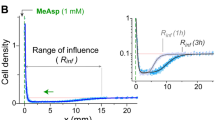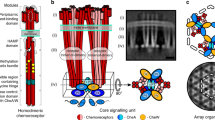Abstract
Chemotactic bacteria such as Escherichia coli can detect and respond to extremely low concentrations of attractants, concentrations of less than 5 nM in the case of aspartate1. They also sense gradients of attractants extending over five orders of magnitude in concentration (up to 1 mM aspartate)2,3. Here we consider the possibility that this combination of sensitivity and range of response depends on the clustering of chemotactic receptors on the surface of the bacterium4. We examine what will happen if ligand binding changes the activity of a receptor, propagating this change in activity to neighbouring receptors in a cluster5,6. Calculations based on these assumptions show that sensitivity to extracellular ligands increases with the extent of spread of activity through an array of receptors, but that the range of concentrations over which the array works is severely diminished. However, a combination of low threshold of response and wide dynamic range can be attained if the cell has both clusters and single receptors on its surface, particularly if the extent of activity spread can adapt to external conditions. A mechanism of this kind can account quantitatively for the sensitivity and response range of E. coli to aspartate.
This is a preview of subscription content, access via your institution
Access options
Subscribe to this journal
Receive 51 print issues and online access
$199.00 per year
only $3.90 per issue
Buy this article
- Purchase on Springer Link
- Instant access to full article PDF
Prices may be subject to local taxes which are calculated during checkout


Similar content being viewed by others
References
Segall, J. E., Block, S. M. & Berg, H. C. Temporal comparisons in bacterial chemotaxis. Proc. Natl Acad. Sci. USA 83, 8987–8991 (1986).
Mesibov, R., Ordal, G. W. & Adler, J. The range of attractant concentrations for bacterial chemotaxis and the threshold and size of response over this range. Weber law and related phenomena. J. Gen. Physiol. 62, 203–223 (1973).
Berg, H. C. & Tedesco, P. M. Transient response to chemotactic stimuli in Escherichia coli. Proc. Natl Acad. Sci. USA 72, 3235–3239 (1975).
Maddock, J. R. & Shapiro, L. Polar location of the chemoreceptor complex in the Escherichia coli cell. Science 259, 1717–1723 (1993).
Gardina, P. J. & Manson, M. D. Attractant signaling by an aspartate chemoreceptor dimer with a single cytoplasmic domain. Science 274, 425–426 (1996).
Parkinson, J. S. & Blair, D. F. Does E. coli have a nose? Science 259, 1701–1702 (1993).
Stock, J. B. & Surette, M. G. in Escherichia and Salmonella: Cellular and Molecular Biology(ed. Neidhardt, F. C.) 1103–1129 (Am. Soc. Microbiol., Washington DC, (1996).
Eisenbach, M. Control of bacterial chemotaxis. Mol. Microbiol. 4, 161–167 (1996).
Barkai, N. & Leibler, S. Robustness in simple biochemical networks. Nature 387, 913–917 (1997).
Gegner, J. A., Graham, D. R., Roth, A. F. & Dahlquist, F. W. Assembly of an MPC receptor, CheW, and kinase CheA complex in the bacterial chemotaxis signal transduction pathway. Cell 70, 975–982 (1992).
Li, J. Y., Li, G. Y. & Weis, R. M. The serine chemoreceptor from Escherichia coli is methylated through an interdimer process. Biochemistry 36, 11851–11857 (1997).
Schuster, S. C., Swanson, R. V., Alex, L. A., Bourret, R. B. & Simon, M. I. Assembly and function of a quaternary signal transduction complex monitored by surface plasmon resonance. Nature 365, 343–346 (1993).
Barak, R. & Eisenbach, M. Correlation between phosphorylation of the chemotaxis protein CheY and its activity at the flagellar motor. Biochemistry 31, 1821–1826 (1992).
Ninfa, E. G., Stock, A., Mowbray, S. & Stock, J. Reconstitution of the bacterial chemotaxis signal transduction system from purified components. J. Biol. Chem. 266, 9764–9770 (1991).
Stewart, R. C. Activating and inhibitory mutations in the regulatory domain of CheB, the methylesterase in bacterial chemotaxis. J. Biol. Chem. 266, 1921–1930 (1993).
Lukat, G. S., McCleary, W. R., Stock, A. M. & Stock, J. B. Phosphorylation of bacterial response regulator proteins by low molecular weight phospho-donors. Proc. Natl Acad. Sci. USA 89, 718–722 (1992).
Kuo, S. C. & Koshland, D. E. J Multiple kinetic states for the flagellar motor switch. J. Bacteriol. 171, 6279–6287 (1989).
Bray, D., Bourret, R. B. & Simon, M. I. Computer simulation of the phosphorylation cascade controlling bacterial chemotaxis. Mol. Biol. Cell 4, 469–482 (1993).
Levin, M. D., Morton-Firth, C. J., Abouhamad, W. N., Bourret, R. B. & Bray, D. Origins of individual swimming behavior in bacteria. Biophys. J. 74, 175–181 (1998).
Biemann, H.-P. & Koshland, D. E. Aspartate receptors of Escherichia coli and Salmonella typhimurium bind ligand with negative and half-of-sites cooperativity. Biochemistry 33, 629–634 (1994).
Aksamit, R. R., Howlett, B. J. & Koshland, D. E. J Soluble and membrane-bound aspartate-binding activities in Salmonella typhimurium. J. Bacteriol. 123, 1000–1005 (1975).
Khan, S.et al. Excitatory signaling in bacteria probed by caged chemoeffectors. Biophys. J. 65, 2368–2382 (1993).
Hazelbauer, G. L., Engstrom, P. & Harayama, S. Methyl-accepting chemotaxis protein III and transducer gene trg. J. Bacteriol. 145, 43–49 (1981).
Borkovich, K. A., Alex, L. A. & Simon, M. I. Attenuation of sensory receptor signaling by covalent modification. Proc. Natl Acad. Sci. USA 89, 6756–6760 (1992).
Yonekawa, H. & Hayashi, H. Desensitization by covalent modification of the chemoreceptor of Escherichia coli. FEBS Lett. 198, 21–24 (1986).
Wu, J., Li, J., Li, G., Long, D. G. & Weis, R. M. The receptor binding site for the methyltransferase of bacterial chemotaxis is distinct from the sites of methylation. Biochemistry 35, 4984–4993 (1996).
Stock, A. M., Koshland, D. E. J & Stock, J. B. Homologies between the Salmonella typhimurium CheY protein and proteins involved in the regulation of chemotaxis, membrane protein synthesis, and sporulation. Proc. Natl Acad. Sci. USA 82, 7989–7993 (1985).
Acknowledgements
We thank M. Keeling for help with mathematics, S. Khan for permission to cite unpublished data, and R. Bourret, E. Siggia and T. Lamb for criticisms of the manuscript.
Author information
Authors and Affiliations
Corresponding author
Rights and permissions
About this article
Cite this article
Bray, D., Levin, M. & Morton-Firth, C. Receptor clustering as a cellular mechanism to control sensitivity. Nature 393, 85–88 (1998). https://doi.org/10.1038/30018
Received:
Accepted:
Issue Date:
DOI: https://doi.org/10.1038/30018
This article is cited by
-
Biological Systems: Reliable Functions out of Randomness
Journal of Systems Science and Complexity (2021)
-
Molecular model of a sensor of two-component signaling system
Scientific Reports (2021)
-
Integrin nanoclusters can bridge thin matrix fibres to form cell–matrix adhesions
Nature Materials (2019)
-
Using enhanced number and brightness to measure protein oligomerization dynamics in live cells
Nature Protocols (2019)
-
The transducer-like protein Tlp12 of Campylobacter jejuni is involved in glutamate and pyruvate chemotaxis
BMC Microbiology (2018)
Comments
By submitting a comment you agree to abide by our Terms and Community Guidelines. If you find something abusive or that does not comply with our terms or guidelines please flag it as inappropriate.



